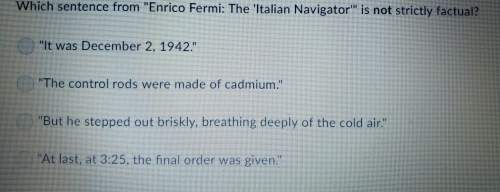
History, 30.07.2019 06:30 annajquinterov
The main purpose of the us passing the neutrality act in 1939 on a “cash and carry” basis was to question 1 options: encourage other countries in central america and south america to send troops to support france limit the spread of nazi influence while remaining neutral, by selling the british and the french supplies declare war on japan and defeat them quickly before joining the war in europe allow the us to secretly funnel money in to germany and japan to fund their war efforts – this led to great profit for the us economy what was the main reason why the us officially joined wwii on the allies’ side? question 2 options: the us was concerned that germany was close to creating and using an atomic bomb in europe the surprise attack at pearl harbor in hawaii on december 7th, 1941, killing americans and destroying american ships and airplanes. the zimmerman telegram was intercepted, and the us was worried that germany was attempting to get mexico to attack from the south all of these

Answers: 1


Another question on History

History, 21.06.2019 19:10
30 ! seneca falls: common ground by andrea brecheen the seneca falls convention of 1848 was the single-most important event of the early women's suffrage movement. the suffrage movement grew out of centuries of shameful and unfair treatment of women. at the time of the convention, women did not have the right to vote or serve on juries, and many women were unable to inherit property. in the decades leading up to the convention, a small group of women began to rebel against these injustices. suffrage originated from women's participation in the anti-slavery and temperance movements. the seneca falls convention was the first conference dedicated to women's rights. the convention was organized by two female abolitionists, elizabeth cady stanton and lucretia mott. lucretia mott was an eloquent quaker social reformer. mott had previously been denied the right to speak at an anti-slavery conference in london after the men voted to exclude women from participating. unlike many women of her time, elizabeth cady stanton received a formal education. at the age of 16, stanton studied mathematics, latin, and greek, demonstrating her keen abilities by mastering the subjects alongside boys of her own age. coming together to support the suffrage movement, mott and stanton organized the convention in seneca falls, ny in july of 1848. during the six-day meeting, stanton presented the declaration of sentiments, a document she based on the declaration of independence. in the declaration, she so elegantly wrote, "we hold these truths to be self-evident: that all men and women are created equal." the declaration included a list of grievances detailing the treatment of women. the declaration was signed by sixty-eight women and thirty-two men. following the convention, in 1848 the new york state assembly passed the married women's act. this act protected property that women brought into or earned during marriage. read the passage. which sentence best represents a fact about elizabeth cady stanton detailed in the text? a "unlike many women of her time, elizabeth cady stanton received a formal education." b "in the declaration, she so elegantly wrote, 'we hold these truths to be self-evident: that all men and women are created equal.'" c "stanton rightly believed it should the law should be changed to make it easier for women to get divorces and keep their access to their children." d "at the age of 16, stanton studied mathematics, latin, and greek, demonstrating her keen abilities by mastering the subjects alongside boys of her own age."
Answers: 2

History, 21.06.2019 21:10
Which best explains how wealthy residents of italian cities contributed to the renaissance? a) wealthy residents bought works of art, which supported artists. b) wealthy residents participated in religion, which supported the church c) wealthy residents participated in music, which supported the arts. d) wealthy residents bought classical books, which supported scholars.
Answers: 1

History, 22.06.2019 00:20
Before the invention of the loom in 1785, textile manufacturing was: a) regulated under the guild system. b) performed by children working in factories. c) produced in rural cottages under a putting-out system. d) conducted by british colonists overseas.
Answers: 1

You know the right answer?
The main purpose of the us passing the neutrality act in 1939 on a “cash and carry” basis was to que...
Questions

Mathematics, 14.02.2021 05:20


Advanced Placement (AP), 14.02.2021 05:20

Arts, 14.02.2021 05:20

Spanish, 14.02.2021 05:20


Mathematics, 14.02.2021 05:20







Mathematics, 14.02.2021 05:20

Arts, 14.02.2021 05:20

Mathematics, 14.02.2021 05:20



Chemistry, 14.02.2021 05:20




